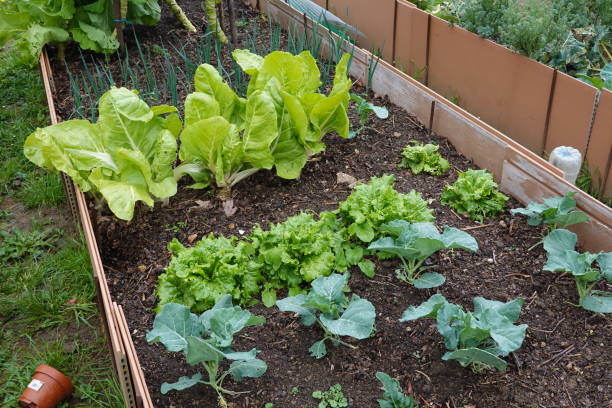Companion planting, an organic gardening technique in which selected plants are grown as companions for mutual benefit, can significantly enhance the growth and flavor of your crops. For one, fragrant herbs make great companions for cabbage plants, and their strong scent can mask the scent of your leafy greens so pests can’t locate your crops.
Natural pest control plants also repel certain pests. By strategically pairing plants, gardeners can improve nutrient uptake, deter pests, and attract beneficial insects, thereby creating a harmonious ecosystem in the garden.

When it comes to leafy greens like cabbage and lettuce, knowing the right companions can make all the difference in achieving a lush and productive vegetable garden biodiversity. The following sections delve into the companion planting benefits for veggies, highlight the best companion plants, and offer tips for successful planting.
Top Companion Plants For Cabbage

will give it a better chance
This method of planting is not just a trendy gardening tip or about growing companion plants alongside your cabbage, but about finding compatible plants like herbs, flowers, and vegetables to boost growth. This technique is a proven practice that can lead to bountiful harvests and vibrant plants. When cabbage and lettuce are paired with cabbage companion vegetables, they thrive better.
When it comes to cabbage, pairing it with herbs is a healthy combination. Some of the best herbs for cabbage include thyme, chamomile, mint, hyssop, and many more. These herbs repel insects like spider mites and cabbage moths. Adding pollinator-friendly flowers also attracts insects like bees and adds flavor, nutrients, and vitamins to the plant.
Cabbage can also be planted alongside marigolds for pest control. Marigolds rid you of whiteflies and mosquitoes and help rid you of pests like squash bugs, cucumber beetles, and so on. It’s quite interesting how nature bonds these plants, like best friends who thrive together, supporting each other to grow delightfully.
Ideal Companion Plants For Lettuce

Lettuce is one of the fastest-growing vegetables, so it’s no wonder it is a popular choice in most vegetable gardens. It is tasty and one of the first vegetables to come out in spring, yet delicate. When considering companions for lettuce, you want plants that harmonize well in both nutrient needs and growth habits—lettuce benefits greatly from companion herbs, particularly flavor-enhancing herbs and edible flowers.
For example, planting basil alongside your lettuce can boost its flavor and scent. Interplanting lettuce with edible flowers like nasturtiums not only attracts pollinators but also serves as a trap crop for aphids, drawing them away from your lettuce. In addition, you may consider nutrient-boosting vegetables such as radishes to help break up the soil, promoting aeration and moisture retention around the slower-growing lettuce, allowing the root systems to coexist happily.
Avoid Plants That Hinder Cabbage And Lettuce Growth
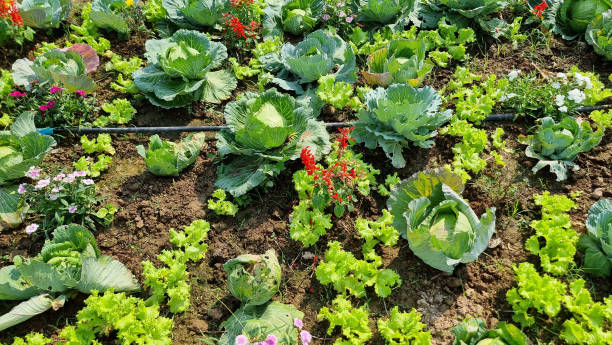
While Companion planting offers a variety of benefits, it is essential to be aware of plants that hinder rather than help your cabbage and lettuce. Plants to avoid with lettuce and cabbage include strawberries, Brussels sprouts, and kale. They belong to one family and will compete for the same nutrients, leading to delayed growth.
Planting lettuce near strawberries is a definite NO, as they can inhibit each other’s growth. It is essential to avoid incompatible garden combinations, as they may affect your lettuce negatively.
Bad companions for cabbage include strawberries, cruciferous plants, garlic, leeks, and onions. Some of the garden planting mistakes often made in companion planting include choosing an incompatible companion that may eventually lead to damaged plants and small spacing.
Best Planting Techniques For Companion Plants
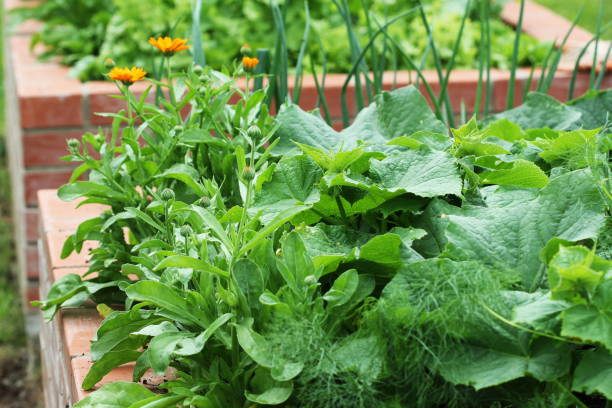
There are various strategies that farmers employ in companion planting for optimal development. Intercropping is a valuable tool for many reasons. The intercropping method is an old-fashioned method that is being adopted by modern gardeners. It allows spaces that promote the formation of competitive plants, enhance soil fertility, and encourage a harmonious climate for the plants to thrive.
The ultimate garden plant spacing tip is that there is no one-size-fits-all or yardstick for vegetable bed layout. If you plant them too closely together, their roots will begin to compete with each other for daily nutrients, sunlight, and water, especially in companion planting using mixed planting guides. Don’t forget to follow spacing guidelines on plant tags, but you may have to leave room between rows for the paths.
Seasonal Considerations For Planting Companions
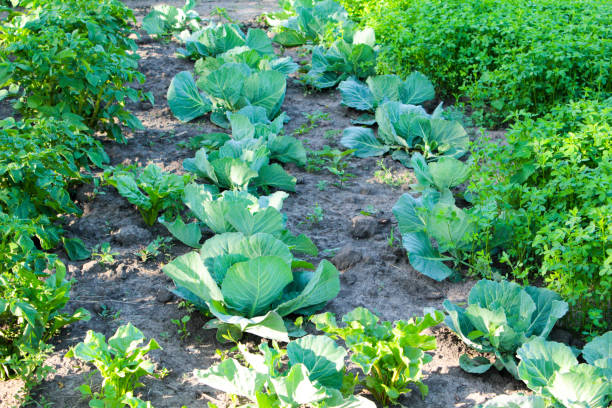
In successful companion planting, timing is everything. For instance, cabbage and lettuce thrive in cooler seasons. When choosing companions, ensure they match or complement their growth cycle to improve efficiency.
Understanding the growing seasons of your crops ensures that you plant them when conditions are just right.
Cool-season vegetables like cabbage or lettuce develop and thrive better in cool weather conditions, such as fall or spring. Include cabbage in your spring vegetable garden using a good seasonal planting guide.
Some other fall planting tips include using fall as the best time to plant spring-flowering bulbs, cabbage, and lettuce.
Common Mistakes To Avoid In Companion Planting
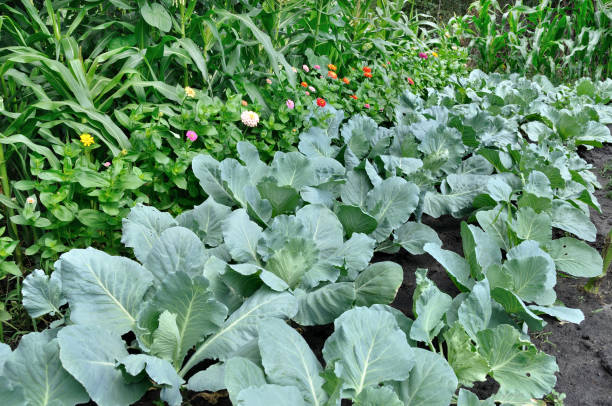
Even seasoned gardeners can make common gardening mistakes when it comes to companion planting. One common mistake is overcrowding and over-planting problems. This can lead to competition for nutrients and sunlight, causing both cabbage and lettuce to underperform.
Another pitfall is crop rotation errors like failing to rotate crops after each year. Replanting the same companions in the same spot can deplete the soil of essential nutrients and promote pests and diseases. In addition, disregarding the plant’s nutrient and water needs in mixed gardens can be detrimental. For instance, pairing a high-water-consuming plant with a drought-tolerant variety may cause stunted growth or plant failure.
How Companion Plants Improve Soil Health For Cabbage And Lettuce

Companion plants like thyme, which are soil improvement plants, help to create a healthy ecosystem for your plants to grow in. Using nitrogen-fixing companion plants is a natural way to enrich your soil without the use of chemical fertilisers. It is mostly successful in intercropping.
One of the best-known nitrogen-fixing companions are legumes. These soil improvers collect nitrogen on their roots and restore it to the soil. Some legumes are better at fixing nitrogen more than others, which is why heavy feeding plants are intercropped with crops like legumes that add nitrogen, making them natural soil enhancers.
For instance, beans and peas benefit potatoes, cucumbers, and carrots. The use of nitrogen-fixing plants in crop rotation allows proper nitrogen fixation for succeeding plants and improves garden soil health.
Attracting Beneficial Insects With Companion Plants

Certain plants, when planted together, protect each other by attracting beneficial insects and pollinators that repel pests and increase plant productivity. They act as natural pest management, protecting the other crops naturally. Planting flowers for vegetable gardens alongside cabbage and lettuce tends to draw pollinators, ladybugs, lacewings, and predatory wasps that keep harmful pests under control even without the use of chemicals.
Companion planting is about creating plant families that benefit one another. With proper planning, we can create a healthy garden that provides food and joy. Some good companion plants for pollinators include herbs like basil, thyme, and oregano.
Conclusion: Maximizing Your Garden’s Potential With Companion Plants
Companion planting is very much a rewarding technique that can help to enhance the productivity and vitality of your lettuce and cabbage crops. Some sustainable gardening tips include selecting the right companions, understanding benefits, and avoiding common pitfalls. You can cultivate a low-maintenance garden plan that helps your garden to not only produce abundant vegetables but also foster a rich ecosystem.
To maximize garden productivity, it is essential to embrace the natural synergy, allowing you to grow much healthier plants that yield better flavors.
Healthy vegetable gardening starts from making the right decisions for your plant’s growth. So, roll up your sleeves, dig into some companion planting, and watch your garden flourish as these leafy greens stand tall alongside their perfect partners.

